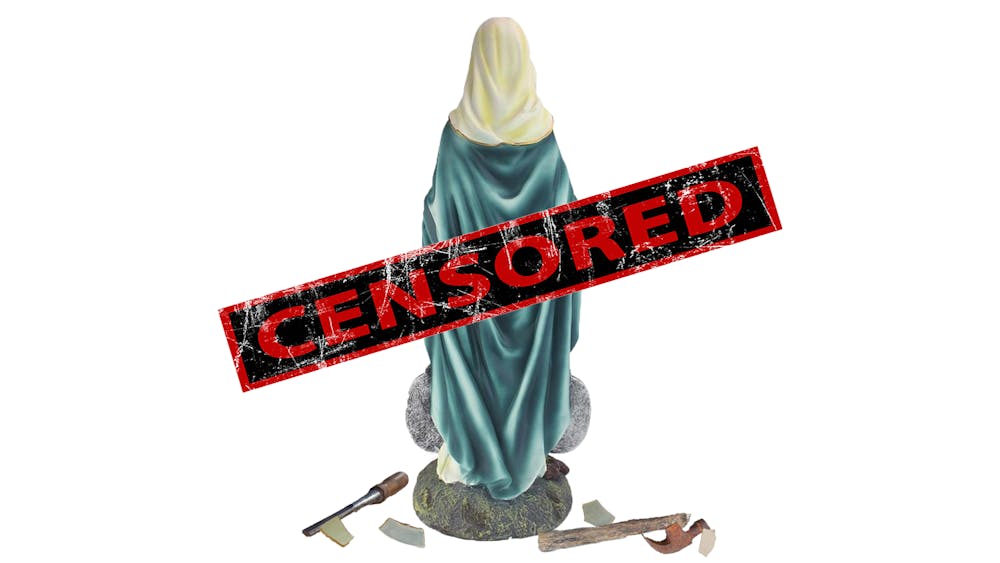Black curtains do more than just shield the public from art. They represent a divide between the morality of censorship for tastelessly sexual or religious minority pieces, and those who feel that policing of media should be curbed at all costs.
At Macalester College in Saint Paul, Minnesota, an artistic showcase depicting exposed niqab and hijab–wearing women has divided students and propels a debate about censorship. Should the masses be allowed to choose whether to view art that shocks into action, or does asking for “visual consent” kill democratic ideals? Amid the chaos is the solo exhibitionist and the creator of controversial “Blasphemy X” artwork, Taravat Talepasand. She is an Iranian–American artist who “explores the cultural taboos that reflect on gender and political authority” and demands a conversation about fine art’s role in religious criticism.
The "Taravat" showcase was briefly taken down after student protests. Upon reopening, Talepasand modified her exhibit, adding coverings, content warnings, and a barcode outsourcing a petition by the Muslim student body, requesting that potential viewers respect their religion by averting their eyes.
This controversy follows a similar event in 2022, taking place in Saint Paul's Hamline University.
Erika López Prater, a former professor of art history, lost her position after showcasing a fourteenth–century painting which depicted the prophet Muhammed’s face. This is generally prohibited in the Muslim faith for several reasons, including to avoid depicting the prophet as a god–like figure. This choice struck outrage among the student body, leading to Prater's removal “without due process.” With a different outlook on the situation, the Muslim Public Affairs Council released a statement in support of the adjunct professor, stating that the painting was shown to students to avoid dispute the misconception of a “monothetic Islamic culture.”
Much of the commentary on "no–exceptions" censorship in the media falls firmly on the side of free speech. A majority of professors at Hamline College moved in support of their dismissed faculty, demanding that the college president leave her role. Dissenters fear that the definition of “offense” will become increasingly oppressive. In the future, there may be a need to take extensive measures to ensure education does not unsettle any student. As a result, controversial, yet considerable, information may be lost.
At the same time, anger over concerning pieces of media persists. A 2010 Tarleton State University play in which Christ would be portrayed as homosexual was canceled. In support of the censorship, Governor David Dewhurst said that “no one should have the right to use government funds or institutions to portray acts that are morally reprehensible to the vast majority of Americans.”
This attempt at a constitutional approach to blocking media is not unfounded. The legal underbelly reflects the disconnected opinions of reporters and college activity. The risk of economic restriction is one strange justification of Dewhurst’s unsuccessful attempt to keep the LGBTQ–lensed Corpus Christi play off–stage, as precedented by the 1998 National Endowment for the Arts v. Finley. This law allows the government to exclude funding from art that doesn’t show “decency and respect for the diverse beliefs and values of the American public." Although indirect, it is reasonable to assume this economic barrier limits the showcasing of smaller artists' antagonistic pieces. It shows that the government is unwilling to stand behind the controversial ends of free speech. At a publicly–funded university like Tarleton State, college administration must take its government finances into consideration when approving performances.
Cases in which college students fight for removal of obscene graphics from their campus are numerous and all–encompassing. Students argue that the images or lectures their school outputs are a direct reflection on the student body. Therefore, delicate action should be taken when choosing to invite external speakers (see the cancellation of the Proud Boys’ speech at Penn State this past year), to select books for the curriculum, or to justify the nature of pro–abortion art strewn across the lawn. Young adults are looking for a difficult balance between expression and sensitivity.
In determining whether censorship of art is viable, we must ask crucial social questions. Is crass criticism more acceptable because of the artist’s identity? Is it the responsibility or right of members of a community to publish work that can be offensive to their own demographic? Is it possible to call inactive people to action without the offensive portrayal of a culture? And finally, where is the line between making a powerful statement about a sensitive religious or cultural topic and simply offending an already widely stigmatized audience? As a balance is approached, these considerations will continue haunting viewers and activists, politicians, and creators. Polarizing topics are notoriously difficult to present well.
It is certainly difficult to see the most vulnerable groups targeted by critical or suggestive artwork. Although it’s easy to find examples in the general public of debate in favor of censorship (for better or for worse), the right to freedom of expression has trumped these opinions. While some may argue that there should be a shift towards less polarizing displays of dissent, meek demonstrations rarely stimulate productive conversation. We need to define the line at which artistic liberty ends and unnecessary slander begins, because it is only then that representation of sensitive topics can be done in a way that wins over the right audience.
We currently sit at a stalemate. Taking a step back to survey the gallery yields a more complete picture than an exhibit alone can offer. Tapestries over pieces ask us to make our own choice. The degree to which censorship is enforced depends, perhaps, on American ideals and economic status. Looking forward, we can expect the debate on the legal and ethical considerations of controversial artwork and the role of social perspective to continue for generations.

